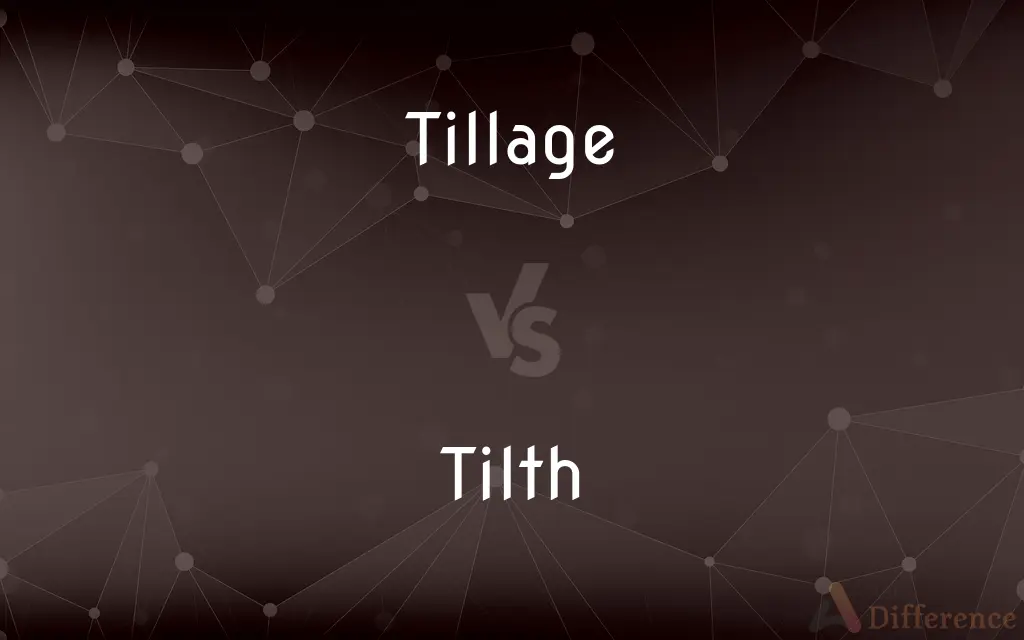Tillage vs. Tilth — What's the Difference?
Edited by Tayyaba Rehman — By Fiza Rafique — Updated on April 3, 2024
Tillage refers to the agricultural preparation of soil by mechanical agitation, whereas tilth describes the soil's physical condition, especially in relation to its suitability for planting.

Difference Between Tillage and Tilth
Table of Contents
ADVERTISEMENT
Key Differences
While tillage directly affects the soil's structure by mechanical means, tilth is more of an outcome, reflecting the soil's overall health and readiness for planting. The relationship between tillage and tilth is interconnected; the method and frequency of tillage can significantly impact the soil's tilth. For example, excessive tillage can degrade soil structure and reduce its quality, while conservation tillage practices are designed to maintain or improve tilth.
Both tillage and tilth are central concepts in agriculture, each playing a distinct role in the preparation and maintenance of land for farming. Tillage practices are chosen based on various factors, including crop requirements, soil type, and environmental considerations, with the goal of achieving optimal tilth for plant growth.
The concept of tilth extends beyond the immediate effects of tillage to encompass broader aspects of soil management, such as the incorporation of organic matter and the maintenance of soil biodiversity. Good tilth supports not only agricultural productivity but also environmental health, through improved water retention, reduced erosion, and enhanced carbon sequestration.
While tillage is an active process of soil preparation, tilth is a measure of the soil's condition resulting from various agricultural practices, including tillage. The goal of sustainable farming practices is to balance effective tillage methods with the preservation of good soil tilth, ensuring long-term soil health and productivity.
Comparison Chart
Definition
Mechanical soil manipulation to prepare for planting.
The physical condition of soil in terms of suitability for planting.
ADVERTISEMENT
Purpose
To break up soil, control weeds, and mix in fertilizers.
To indicate the readiness of soil for successful crop growth.
Impact
Can alter soil structure, affect erosion, and soil health.
Reflects soil health, including structure, aeration, and moisture retention.
Methods
Includes plowing, harrowing, and rototilling.
Improved through organic matter addition, minimal disturbance, and crop rotation.
Outcome
Immediate preparation for seeding or planting.
Long-term soil quality essential for plant health and yield.
Compare with Definitions
Tillage
Agricultural practice of soil preparation.
Tillage before planting helps incorporate nutrients evenly.
Tilth
Affected by tillage and other practices.
Organic farming practices often improve soil tilth.
Tillage
Can vary from deep plowing to minimal soil disturbance.
Conservation tillage reduces erosion and improves water retention.
Tilth
Describes the physical quality of soil.
Soil with good tilth is crumbly and retains moisture well.
Tillage
May involve the use of heavy machinery.
Tractors and plows are commonly used for tillage in large fields.
Tilth
Indicates soil's readiness for planting.
Excellent tilth is crucial for high crop yields.
Tillage
Aims to create optimal conditions for seed germination.
Proper tillage ensures seeds have adequate soil contact.
Tilth
Reflects soil's water retention and aeration.
Good tilth means roots can easily penetrate the soil and access water.
Tillage
Can impact soil health over time.
Repeated tillage can lead to soil compaction and loss of organic matter.
Tilth
Essential for sustainable agriculture.
Maintaining good tilth supports soil biodiversity and health.
Tillage
Tillage is the agricultural preparation of soil by mechanical agitation of various types, such as digging, stirring, and overturning. Examples of human-powered tilling methods using hand tools include shoveling, picking, mattock work, hoeing, and raking.
Tilth
Soil tilth is a physical condition of soil, especially in relation to its suitability for planting or growing a crop. Factors that determine tilth include the formation and stability of aggregated soil particles, moisture content, degree of aeration, soil biota, rate of water infiltration and drainage.
Tillage
Cultivation of land.
Tilth
Cultivation of land; tillage.
Tillage
Land that has been tilled.
Tilth
Tilled earth.
Tillage
The cultivation of arable land by plowing, sowing and raising crops.
Tilth
The fitness of soil for cultivation, as measured by its structure and composition.
Tillage
Land cultivated in this way.
Tilth
Agricultural labour; husbandry.
Tillage
The operation, practice, or art of tilling or preparing land for seed, and keeping the ground in a proper state for the growth of crops.
Tilth
The state of being tilled, or prepared for a crop; culture.
The land is in good tilth and ready to plant.
Tillage
A place tilled or cultivated; cultivated land.
Tilth
Rich cultivated soil.
Tillage
Arable land that is worked by plowing and sowing and raising crops
Tilth
The state of being tilled, or prepared for a crop; culture; as, land is good tilth.
The tilth and rank fertility of its golden youth.
Tillage
The cultivation of soil for raising crops
Tilth
That which is tilled; tillage ground.
And so by tilth and grange . . . We gained the mother city.
Tilth
The state of aggregation of soil and its condition for supporting plant growth
Tilth
Arable land that is worked by plowing and sowing and raising crops
Common Curiosities
How does tillage affect tilth?
Tillage can both positively and negatively affect tilth, depending on the method used; conservation tillage aims to maintain or improve tilth.
What does tilth refer to?
Tilth refers to the physical condition of soil, especially its suitability for planting and supporting plant growth.
Can you improve soil tilth?
Yes, by incorporating organic matter, practicing crop rotation, and reducing soil disturbance.
How do you measure tilth?
Tilth is evaluated based on soil structure, moisture retention, aeration, and ease of root penetration.
How does organic matter affect tilth?
Organic matter improves tilth by enhancing soil structure, moisture retention, and nutrient availability.
How does tillage impact water infiltration?
Proper tillage improves water infiltration, while excessive tillage can reduce it by compacting the soil.
What is tillage?
Tillage is the agricultural process of preparing soil for planting through mechanical agitation.
What role does crop rotation play in maintaining tilth?
Crop rotation helps maintain tilth by preventing soil-borne diseases and improving soil structure.
Why is minimal soil disturbance recommended?
Minimal disturbance helps preserve soil structure, reduce erosion, and maintain higher levels of organic matter.
Why is good tilth important?
Good tilth is crucial for healthy plant growth, efficient water use, and sustainable soil health.
How do modern farming practices impact tilth?
Sustainable practices aim to improve tilth, while some conventional practices may degrade it over time.
Is no-till farming better for soil tilth?
No-till farming can improve soil tilth by minimizing disturbance and preserving soil structure.
What are the benefits of conservation tillage?
Conservation tillage reduces erosion, improves water retention, and enhances soil biodiversity.
Can excessive tillage harm soil?
Yes, excessive tillage can compact soil, degrade its structure, and reduce organic matter content.
Can tillage affect soil biodiversity?
Yes, tillage can disrupt soil ecosystems, affecting worms, microbes, and other beneficial organisms.
Share Your Discovery

Previous Comparison
Emphasis vs. Stress
Next Comparison
Butane vs. HexaneAuthor Spotlight
Written by
Fiza RafiqueFiza Rafique is a skilled content writer at AskDifference.com, where she meticulously refines and enhances written pieces. Drawing from her vast editorial expertise, Fiza ensures clarity, accuracy, and precision in every article. Passionate about language, she continually seeks to elevate the quality of content for readers worldwide.
Edited by
Tayyaba RehmanTayyaba Rehman is a distinguished writer, currently serving as a primary contributor to askdifference.com. As a researcher in semantics and etymology, Tayyaba's passion for the complexity of languages and their distinctions has found a perfect home on the platform. Tayyaba delves into the intricacies of language, distinguishing between commonly confused words and phrases, thereby providing clarity for readers worldwide.














































